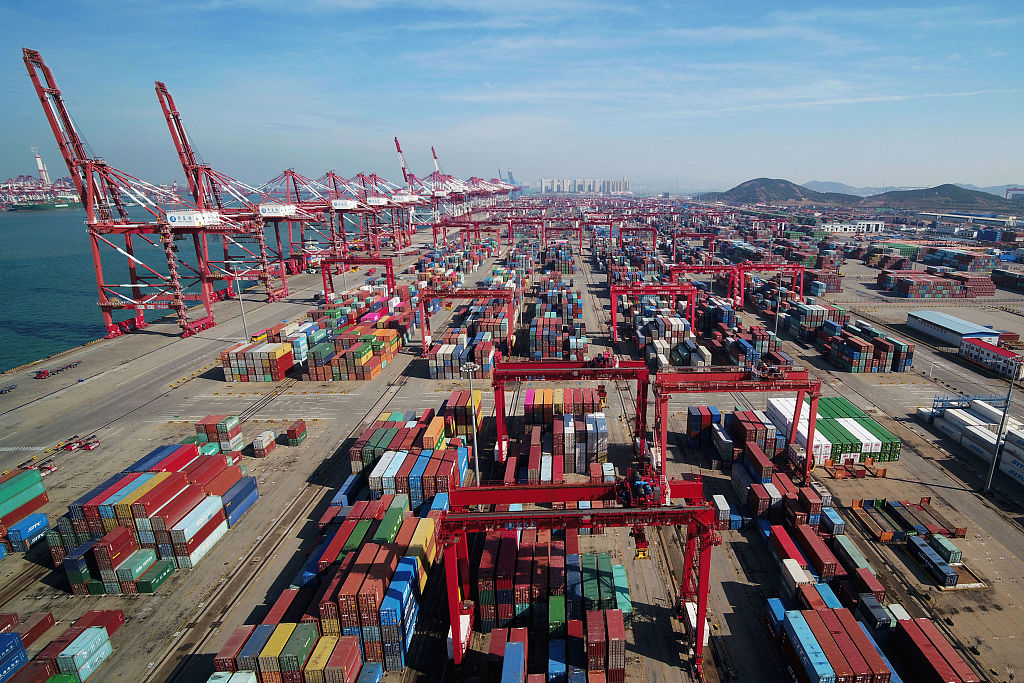

Editor's note: The article was first published by China Plus on September 9, 2019. The article does not necessarily reflect the views of CGTN.
The latest data released by the General Administration of Customs of China shows that the total value of China's import and export of goods in the first eight months of this year reached 20.13 trillion yuan, an increase of 3.6 percent over the same period last year. Under the current complicated and severe circumstances, this represents a hard-won achievement. It shows that the long-term fundamentals of China's economy have not changed, nor has the trend of continuous and stable improvement of quality, together showing great resilience and potential.
In the face of unilateralism and protectionism, the World Trade Organization lowered its forecast for global trade growth this year to 2.6 percent from the previous 3.7 percent. Against the background of an overall downturn in global trade, China’s foreign trade has maintained steady growth and quality improvement in the first eight months of this year, which is particularly eye-catching. This has manifested itself in three principal ways.
Firstly, China's import and export structure continues to optimize itself at the higher end of the industrial chain. In the first eight months of this year, China's higher value-added imports and exports increased by 5.4 percent year-on-year, accounting for nearly 60 percent of the total value of foreign trade. At the same time, China's export-oriented industries shifted to capital and technology-intensive industries including equipment manufacturing and high- and new-tech industries. Among them, exports of mechanical and electrical products increased by 5.6 percent year-on-year, accounting for 57.9 percent of the total value of exports, indicating that the pace of transformation and upgrading has further accelerated.
Secondly, China's import and export market is increasingly diversified, and the ability of enterprises to resist risks has increased. In the first eight months of this year, China’s imports and exports to major markets including the EU, ASEAN and Japan increased by 9.7 percent, 11.7 percent, and 0.7 percent, respectively. The growth rate of imports and exports along the "Belt and Road" countries was 6.3 percentage points higher than the overall growth rate, which is considered to be a big highlight. Daniel Gros, the director of the Center for European Policy Studies in Brussels noted in a media interview that even if the United States, whose economy accounts for a quarter of the global total, shuts down its market to China, some industries in China will suffer, but three-quarters of the world will remain open. Therefore, he believes the United States cannot stop China's growth.

A view of the Qingdao Port, Shandong Province, on November 8, 2018. /VCG Photo
Thirdly, private enterprises continue to be an important driving force in China's foreign trade. In the first eight months of this year, the import and export of private enterprises increased rapidly by 11.2 percent year-on-year, accounting for 42.2 percent of total foreign trade, indicating that the domestic growth momentum of foreign trade has seen a continuous enhancement.
It is noteworthy that in the first eight months of this year, China's exports to the United States were 1.88 trillion yuan, down 3.7 percent year-on-year; imports from the United States were 540.5 billion yuan, down 23.5 percent year-on-year. The big gap between imports and exports shows that U.S. exports to China are more substitutable. In the same period, China's trade surplus with the United States was 1.33 trillion yuan, an increase of 7.7 percent, indicating that the increase in tariffs goes no way towards solving the problem. At a recently concluded high-level autumn summit of the China Development Forum, the participants called on China and the United States to handle their differences through communication and rationality. Among them, former deputy U.S. Treasury Secretary Neal Wolin said that there is no more important bilateral relationship in the world than U.S.-China relations. As the world's two largest economies, cooperation between the United States and China is the only right choice for the two countries.
In the context of the current slowdown in world economic and trade growth, the monthly import and export value of China's trade exceeded 2.5 trillion yuan for five consecutive months, showing a strong tenacity, which largely resulted from China's unswerving expansion of its opening-up. A series of measures, including the construction of the Shenzhen Demonstration Pilot Zone and the Shanghai Free Trade Zone's Lingang New Area, the addition of six free trade pilot zones, the implementation of a larger tax reduction policy, and the raising of trade facilitation levels, are promoting China's opening-up. The country is turning from a flow of products and services to a higher level of institutional openness, which has injected a strong impetus into China's foreign trade development.
At the same time, the domestic power of Chinese enterprises has been continuously enhanced, providing important support for foreign trade. At present, the foreign trade value of private- and foreign-funded enterprises each accounts for about 40 percent of China's total import and export value. With the rapid growth of private enterprises and the continued deep penetration of foreign-funded enterprises into the Chinese market, the vitality of market players will be further enhanced, and the internal driving forces for promoting foreign trade development will also be more powerful.
Against the background of an uncertain external environment, China's foreign trade is stably rising in quality, which is conducive to the efforts by enterprises to further accelerate technological innovation, increase the added value of their products, raise labor productivity, and enhance the ability to withstand risks.
(If you want to contribute and have specific expertise, please contact us at opinions@cgtn.com)

Copyright © 2018 CGTN. Beijing ICP prepared NO.16065310-3
Copyright © 2018 CGTN. Beijing ICP prepared NO.16065310-3